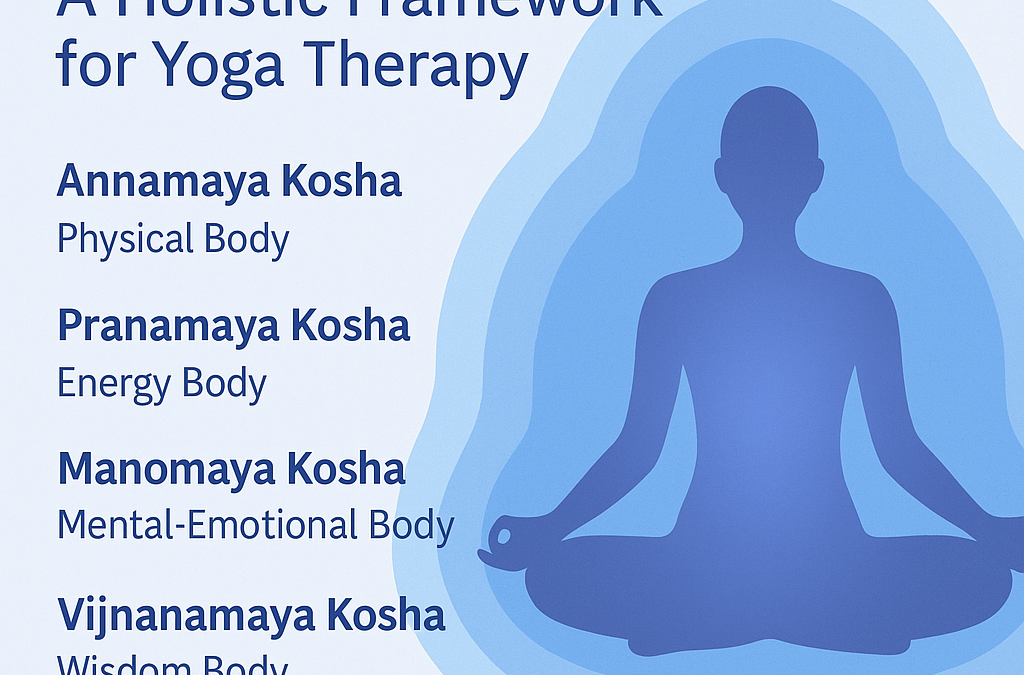The Pancha Kosha (Five Sheaths) model, rooted in the Taittiriya Upanishad, offers a profound lens for understanding the multidimensional nature of human health. It teaches that well-being isn’t simply the absence of symptoms—but harmony across five interrelated layers: physical, energetic, mental-emotional, intuitive, and spiritual.
In yoga therapy, this model guides us to address not just pain or dysfunction, but the whole person. Today, clinical research increasingly supports what yogic sages long understood: true, sustainable healing unfolds when all layers of being are nourished.
Let’s explore each kosha through the lens of both traditional practice and modern evidence.
1. Annamaya Kosha (Physical Body)
This outermost sheath is the body made of food—muscles, bones, tissues, and organs. It’s often the first place we notice symptoms.
Key Therapeutic Tools:
- Adaptive asana modifications
- Structural alignment techniques
- Restorative yoga postures
- Sukshma Vyayama (subtle joint movements)
- Lifestyle and nutritional support
Clinical Evidence:
- Chronic Pain: 37% reduction after 12-week yoga program (Sherman et al., Annals of Internal Medicine)
- Arthritis: 42% improvement in mobility and pain (Moonaz et al., Journal of Rheumatology)
- Post-Surgery Recovery: 28% faster than standard PT (Groessl et al., Military Medicine)
- Biomechanics: EMG studies show better muscle activation during asana (Coulter et al., Yoga Journal of Medicine)
2. Pranamaya Kosha (Energy Body)
This layer governs prana (life force) and breath, flowing through subtle channels (nadis). Imbalances here may manifest as anxiety, fatigue, or shallow breathing.
Key Therapeutic Tools:
- Pranayama (e.g., Nadi Shodhana, Bhramari)
- Breath-movement coordination
- Bandhas (energy locks)
- Marma point stimulation
- Biofeedback-guided breathing
- Shatkriya, Vayus, and diet for energetic balance
Clinical Evidence:
- Anxiety: 34% reduction from pranayama (Zope & Zope, Journal of Clinical Psychiatry)
- COPD: 22% improved lung function (Donesky-Cuenco et al., CHEST)
- HRV: 41% increase in heart rate variability (Satyapriya et al., Indian Journal of Medical Research)
- Hypertension: Blood pressure drop by 11–15 mmHg (Pal et al., Lancet)
3. Manomaya Kosha (Mental-Emotional Body)
This sheath governs the mind, emotions, and sensory input. Trauma, stress, or grief often lodge here when unresolved.
Key Therapeutic Tools:
- Mindfulness-Based Stress Reduction (MBSR)
- Yoga Nidra (yogic sleep)
- Mantra repetition
- Yoga-informed counseling
- Visualization and guided imagery
- Emotional hygiene practices
Clinical Evidence:
- PTSD: 52% reduction in symptoms among veterans (Journal of Traumatic Stress)
- Depression: Yoga as effective as SSRIs (Uebelacker et al., Journal of Clinical Psychology)
- Insomnia: 38% improvement in sleep efficiency (Khalsa et al., Sleep Medicine Reviews)
- Cognitive Function: Enhanced gray matter in meditators (Lazar et al., NeuroReport)
4. Vijnanamaya Kosha (Wisdom Body)
This layer involves discernment, intuition, and alignment with life purpose. Healing here supports clarity and self-leadership.
Key Therapeutic Tools:
- Jnana Yoga (self-inquiry)
- Cognitive reframing through yogic philosophy
- Yogic counseling and reflection
Clinical Evidence:
- Addiction Recovery: 60% lower relapse (Khanna et al., Journal of Addiction Medicine)
- Chronic Illness Coping: 44% improved adaptive thinking (Carson et al., Pain Management Nursing)
- Insight: Increased prefrontal cortex activity (Kakumanu et al., International Journal of Yoga)
- Self-Efficacy: 35% rise in self-care behaviors (Galantino et al., EBCAM)
5. Anandamaya Kosha (Bliss Body)
The innermost sheath reflects joy, unity, and spiritual connection. It’s accessed not by striving—but through presence, love, and transcendence.
Key Therapeutic Tools:
- Bhakti Yoga (devotion)
- Karma Yoga (selfless service)
- Compassion and loving-kindness meditation
- Gratitude journaling
- Awe cultivation and spiritual practice
Clinical Evidence:
- End-of-Life Care: 58% drop in existential distress (Lipschitz et al., Journal of Palliative Medicine)
- Burnout: 47% decrease in emotional exhaustion (Gura et al., Alternative Therapies)
- Neurochemistry: Boosted dopamine/serotonin (Newberg et al., PLOS One)
- Quality of Life: 32% improvement in WHOQOL scores (Rani et al., Journal of Ayurveda)
Conclusion: A Roadmap for Wholeness
The Pancha Kosha model reminds us that healing is not linear or one-dimensional—it’s layered, fluid, and deeply personal. While physical pain may lead someone to yoga therapy, lasting transformation comes from supporting the entire being: body, breath, mind, insight, and spirit.
Yoga therapy isn’t just about symptom relief. It’s about reconnecting with the fullness of who we are. The koshas offer a map—ancient, adaptable, and clinically supported—for guiding this journey with compassion, integrity, and wisdom.
References
- Sherman, K. J., et al. (2019). Annals of Internal Medicine
- Moonaz, S. H., et al. Journal of Rheumatology
- Groessl, E. J., et al. Military Medicine
- Coulter, H. D., et al. Yoga Journal of Medicine
- Zope, S. A., & Zope, R. A. Journal of Clinical Psychiatry
- Donesky-Cuenco, D., et al. CHEST Journal
- Satyapriya, M., et al. Indian Journal of Medical Research
- Pal, G. K., et al. Lancet
- Stankovic, L. Journal of Traumatic Stress
- Uebelacker, L. A., et al. Journal of Clinical Psychology
- Khalsa, S. B. S., et al. Sleep Medicine Reviews
- Lazar, S. W., et al. NeuroReport
- Khanna, S., et al. Journal of Addiction Medicine
- Carson, J. W., et al. Pain Management Nursing
- Kakumanu, L., et al. International Journal of Yoga
- Galantino, M. L., et al. Evidence-Based Complementary and Alternative Medicine
- Lipschitz, D. L., et al. Journal of Palliative Medicine
- Gura, S. T., et al. Alternative Therapies in Health and Medicine
- Newberg, A. B., et al. PLOS One
- Rani, R., et al. Journal of Ayurveda

